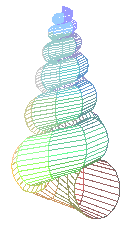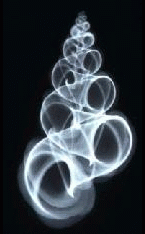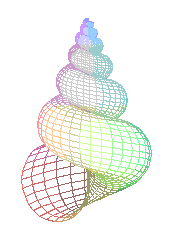
The Mathematical Study of Mollusk Shells
5. Mathematical models of helical shells
Once the constants c and v are known, the entire
shell can be generated from the knowledge of one cross-section:
each point (x,y,z) generates the curve
F(t) = e^(vt)(x cos(ct) + y sin(ct), -x sin(ct) + y cos(ct), z),
and these curves together generate the entire surface of the shell.
In generating the models for this column,
I have assumed that the
section is an ellipse in the (x,z)-plane, of the form
(h + a cos s, 0, k + b sin s), for s between
0 and 2 Pi. (For more general cross-sections see
Randolf Schultz's Shelly
page.)
The Maple instruction that generates
the mathematical models is
plot3d([exp(v*t)*(h+a*cos(s))*cos(t),-exp(v*t)*(h+a*cos(s))*sin(t),
exp(v*t)*(k+b*sin(s))],s=0..2*Pi,t=-10..-1,grid=[30,50],scaling=constrained);
The constants v,a,b,h,k were chosen by eye, without careful
measurements, to give the best match to the available images. Their
effect on the shape of the shells is shown in
the examples below and in the Flat-coil examples (k=0).

v=.05, c=1, a=1,
b=1.2, h=1.5,
k=-8.5,
t=-40..-1
|

Radiograph of Epitonum scalare. This is half of
a stereo
pair from Peter Abrahams' page and is used with permission.
|

Epitonum scalare, the Precious Wentletrap. Image from
Sanibel Seashell Industries, used with permission.
|

v=.075, c=1, a=1.6, b=1.6, h=1.5, k=-7,
t=-40..-1
|

Fossil Pseudoheliceras subcatenatum
(an Ammonite). Image @2000 Jim Craig from
Fossils of the
Gault Clay and Folkestone Beds of Kent, UK,
used with permission. Note that this shell coils
to the left. |

v=.18, c=1, a=2.6, b=2.4, h=1.25, k=-2.8,
t=-20..1
|

Natica stellata, Orange Moon. Image from
Sanibel Seashell Industries, used with permission.
|
|
@ Copyright 2001, American Mathematical Society.







